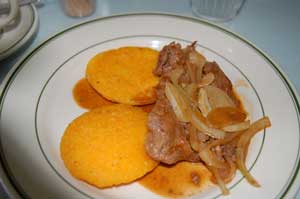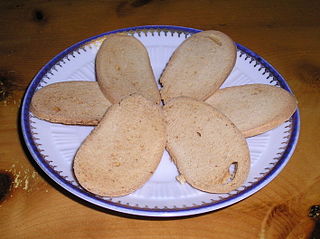| Place of origin | Italy |
|---|---|
| Region or state | Venice, Veneto |
| Main ingredients | Molasses, lard, white pepper, flour |
Pevarini (misspelled peverini in one notable source [1] ) are a traditional pepper cookie of Venice. [2] They are traditionally made with molasses, lard, white pepper, and flour. [2] [3] Modern recipes for pevarini often use butter as a substitute for lard. [2] [4] Spices such as cinnamon, nutmeg, and cloves are common additions to the cookie. [2] [4]
Pevarini take their name from pevare, which means "pepper" in the Venetian dialect. [4]

Moroccan cuisine is the cuisine of Morocco, fueled by interactions and exchanges with many cultures and nations over the centuries. Moroccan cuisine is usually a mix of Arab, Berber, Andalusi, and Mediterranean cuisines, with minimal European and sub-Saharan influences. Like the rest of the Maghrebi cuisine, Moroccan cuisine has more in common with Middle Eastern cuisine than with the rest of Africa.

Hungarian or Magyar cuisine is the cuisine characteristic of the nation of Hungary, and its primary ethnic group, the Magyars. Hungarian cuisine has been described as being the spiciest cuisine in Europe This can largely be attributed to the use of their piquant native spice, Hungarian paprika, in many of their dishes. A mild version of the spice, Hungarian sweet paprika, is commonly used as an alternative. Traditional Hungarian dishes are primarily based on meats, seasonal vegetables, fruits, bread, and dairy products.

Hallaca is a traditional Venezuelan dish. Its origin is indigenous, but raisins, capers, olives, and sometimes bits of bacon were added in the 16th Century and after by settlers from the Iberian peninsula. Hallaca consists of corn dough stuffed with a stew of beef, pork, or chicken and other ingredients such as raisins, capers, and olives, fresh onion rings, red and green bell pepper slices. There are vegetarian hallacas, made with black beans or tofu. Hallacas are folded in plantain leaves, tied with strings, and boiled. The dish is traditionally served during the Christmas season and has several regional variants. It has been described as a national dish of Venezuela. Some speculate it originated from the Orinoquia. Characteristic of the hallaca is the delicate corn dough made with consommé or broth, and lard colored with annatto. Hallacas are also commonly eaten in eastern Cuba, Trinidad where it is called pastelle, and parts of Colombia, Ecuador, Aruba, and Curaçao.

Porchetta is a savory, fatty, and moist boneless pork roast of Italian culinary tradition. The carcass is deboned and spitted or roasted traditionally over wood for at least eight hours, fat and skin still on. In some traditions, porchetta is stuffed with liver and wild fennel, though many versions do not involve stuffing. Porchetta is usually heavily salted and can be stuffed with garlic, rosemary, fennel, or other herbs, often wild. Porchetta has been selected by the Italian Ministry of Agricultural, Food and Forestry Policy as a prodotto agroalimentare tradizionale (PAT), one of a list of traditional Italian foods held to have cultural relevance.

Iraqi cuisine is a Middle Eastern cuisine that has its origins in the ancient Near East culture of the fertile crescent. Tablets found in ancient ruins in Iraq show recipes prepared in the temples during religious festivals—the first cookbooks in the world. Ancient Mesopotamia was home to a sophisticated and highly advanced civilization, in all fields of knowledge, including the culinary arts.

Balearic cuisine is a Mediterranean cuisine as cooked in the Balearic Islands, Spain. It can be regarded as part of a wider Catalan cuisine, since it shares many dishes and ingredients with Catalonia and the Valencian Community. Others view it as part of a more global Spanish cuisine. Traditional Balearic cuisine is rich in vegetables, cereal and legumes as well as being low in fats. A succinct selection of the primary dishes would be ensaimades, seafood and vegetable stews, sobrassada, coques, tombet, Maó cheese and wine.

The cuisine of Senegal is a West African cuisine that derives from the nation's many ethnic groups, the largest being the Wolof. Islam, which first embraced the region in the 11th century, also plays a role in the cuisine. Senegal was a colony of France until 1960. From the time of its colonization, emigrants have brought Senegalese cuisine to many other regions.

Fried plantain is a dish cooked wherever plantains grow, from West Africa to East Africa as well as Central America, the tropical region of northern South America and the Caribbean countries like Haiti to Cuba and in many parts of Southeast Asia and Oceania, where fried snacks are widely popular. In Indonesia it is called gorengan. It is called dodo in Yoruba in South West Nigeria, otherwise known as simply fried plantain in other parts of Nigeria. Kelewele is a fried spicy plantain or can be fried as a side dish for Red Red and fish stew in Ghana.

Saudi Arabian cuisine varies according to the diverse landscapes and regions of the country. The environmental, geographic, and cultural diversity within this vast area has led to a wide variety of dishes. Saudi Arabia encompasses different regions, resulting in cuisines from the Central region, Eastern, Southern and Western regions. Furthermore, Saudi Arabia's position along global trade routes has led to the introduction of various spices. As home to the Muslim holy cities of Mecca and Medina, which millions of people visit annually.

Liver and onions is a dish consisting of slices of liver and bulb onions. The liver and the onions are usually sautéed or otherwise cooked together, but sometimes they may be sautéed separately and mixed together afterwards. The liver is often cut in fine slices, but it also may be diced.

Nigerian cuisine consists of dishes or food items from the hundreds of Native African ethnic groups that comprises Nigeria. Like other West African cuisines, it uses spices and herbs with palm oil or groundnut oil to create deeply flavored sauces and soups.

A polvorón is a type of heavy, soft, and very crumbly Spanish shortbread made of flour, sugar, milk, and nuts. They are mostly produced in Andalusia, where there are about 70 factories that are part of a syndicate that produces polvorones and mantecados. Under the name mantecados, these sweets are a traditional preparation of other areas of the Iberian Peninsula and other Spanish-speaking countries as well.

Chicken paprikash or paprika chicken is a popular dish of Hungarian origin and one of the most famous variations on the paprikás preparations common to Hungarian tables. The name is derived from paprika, a spice commonly used in the country’s cuisine. The meat is typically simmered for an extended period in a sauce that begins with a roux infused with paprika.

Hallongrotta is the name of a common Swedish cookie. The name means raspberry cave in Swedish. In the United States they are known as thumbprint cookies, as well as by many other names. Similar cookies sold in Australia are known as jam drops.

Baicoli are Italian biscuits, originating in the city of Venice. They are made with sugar, butter, flour, yeast, eggs, and salt.

Venetian cuisine, from the city of Venice, Italy, or more widely from the region of Veneto, has a centuries-long history and differs significantly from other cuisines of northern Italy, and of neighbouring Austria and of Slavic countries, despite sharing some commonalities.

Harissa is a hot chili pepper paste, native to the Maghreb. The main ingredients are roasted red peppers, Baklouti peppers (بقلوطي), spices and herbs such as garlic paste, caraway seeds, coriander seeds, cumin and olive oil to carry the oil-soluble flavors.

Chocolate gravy is a variety of gravy made with cocoa powder, sugar, butter and flour and is part of traditional Appalachian cuisine. It is most often served as a Sunday morning dish with fresh biscuits in the Ozark and Appalachian Mountain regions.

Bang bang chicken, also known by variant names such as bam bam chicken or bon bon chicken, is a popular chicken dish in Chinese cuisine. The name bang bang chicken is derived from the Chinese word for stick, bàng (棒), referring to the baton or cudgel traditionally used to tenderize the meat.

The traditional cuisine of Abruzzo is eclectic, drawing on pastoral, mountain, and coastal cuisine. Staples of Abruzzo cuisine include bread, pasta, meat, fish, cheese, and wine. The isolation which has characterized the region for centuries has ensured the independence of its culinary tradition from those of nearby regions. Local cuisine was widely appreciated in a 2013 survey among foreign tourists.